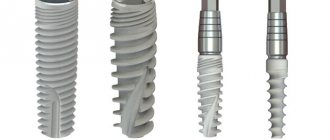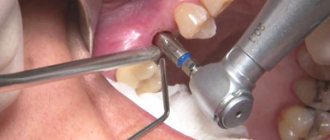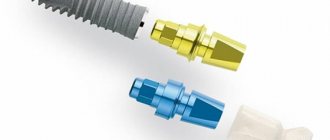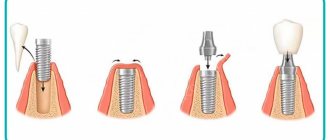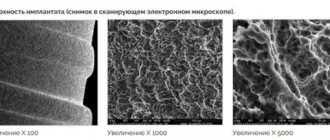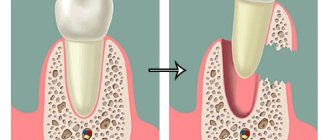Dental implants are a type of artificially developed structures that include several elements, the main function of which is to be inserted into the bone tissue of the jaw.
Over time, the device adheres to hard tissue. In dentistry, this process is called osseointegration.
The ingrown artificial organ becomes identical to the natural one and is a complete substitute for it.
Modern medicine offers patients several types of such prostheses, one of which is Straumann Implants, which will be discussed in this article.
When is prosthetics indicated?
Installing a crown on a tooth is a necessary procedure in situations where the patient:
- the tooth is destroyed as a result of injury, abrasion of enamel or carious lesions,
- extensions, fillings and other treatment methods are not possible,
- the root remained intact.
Some defects, including discoloration of the enamel, lead to an unaesthetic appearance of the entire dentition. The crown will protect the tooth walls from external impacts. Tooth mobility is caused by various periodontal pathologies. In this case, the use of temporary crowns is considered, which make it possible to strengthen the teeth and make them more stable. Crowns are also placed on healthy teeth, which act as support for defects associated with the installation of bridges and dentures.
About the manufacturer
The Swiss company of the same name has been developing and producing structures intended for dental restoration for many years.
A world-famous brand firmly holds a leading position in the market for the production of orthopedic devices. 25% of the total volume of prosthetics sold belongs to Strauman.
For several years, the company's developers have been researching a material that can quickly take root and grow into tissue. They are the author of technical standards that speed up the installation procedure and fastening of the prosthesis several times.
Excellent, time-tested quality, reliability and absolute safety of materials have made the devices in demand not only in the foreign, but also in the Russian market of dental services.
Types of Dental Crowns
There are different options depending on the raw material from which they are made. Each of them has its pros and cons.
Metal
Classic dentures in dentistry. Currently, inexpensive alloys made from medical steel, which is not subject to oxidation and is a durable, wear-resistant material, are often used for the manufacture of orthopedic structures. Disadvantages include an unaesthetic appearance and the risk of allergic reactions. Such dentures are installed on chewing teeth, which are not visible when a person talks or smiles.
Metal ceramics
Such crowns are durable and aesthetically attractive. In addition, their cost is significantly lower than all-ceramic analogues. The disadvantages of this type of prosthetics is that it is impossible to achieve the effect of transparency of the cutting edges in the prosthetic group of the anterior teeth.
Ceramics
The most attractive and expensive option. All-ceramic dentures are made from porcelain processed on a special milling machine. They are very similar to natural teeth. However, ceramics are fragile and cannot withstand significant chewing loads. Therefore, dentures made from it are used to restore front teeth.
Zirconium dioxide
It is not inferior in strength to natural tooth enamel. The material is suitable for the manufacture of solid bridges. The shade of zirconium dioxide can be matched exactly to the color of the patient’s natural teeth. The crowns are completely biologically compatible and safe for human health. They are suitable for patients with metal allergies.
Glass ceramics e.max
The most modern denture technology. The structure of the material is closest to tooth enamel. Externally, crowns are indistinguishable from natural teeth. Glass ceramics are biologically inert and hypoallergenic, while they are impervious to dyes and odors.
How is a crown placed on a tooth?
The procedure takes quite a long time and consists of several stages.
Preparation. At this stage, the doctor draws up a treatment plan, which will depend on the complexity of the particular case, prescribes an x-ray examination and discusses with the patient how the crowns will be installed.
Preliminary treatment may require the removal of teeth if they cannot be restored. A bridge prosthesis involves the use of fixation of several supporting teeth, and one of the points of the plan may be the process of clarifying their number. After this, the cost of installing crowns on the teeth is calculated, and the time frame for manufacturing the prosthetic lock and adaptation to the patient’s oral cavity is determined. After all the preparatory stages before prosthetics, the patient is invited to an orthopedic dentist to treat the supporting teeth and make an impression.
Removal of damaged tissue is carried out using local anesthesia. This also applies to tooth depositing, since during preparation the bur may touch the gums, which may cause discomfort. The condition of the tooth tissue is assessed taking into account the thickness of the crown being installed. Grinding results in the fact that only a stump remains, on which the prosthesis will later be installed.
Making a crown. The doctor takes impressions after preparing all the teeth that will be fixed with single crowns or bridges. Additionally, a 3-dimensional model is created using endoscopic equipment. Using impressions and scan data, dental technicians in the laboratory cast plaster models that are used directly to make the crowns.
Dentures can be made from various materials according to the patient's choice. If the process of producing crowns takes a long time, the patient is provided with plastic structures during this period. This approach not only helps maintain the aesthetics of your smile, but also protects already treated teeth.
Crown fitting. Performed to determine the accuracy of the shape and color of dentures. If the crown fits perfectly, its base is covered with a special ceramic mass. The fitting process can take a long time. At the preparatory stage, the patient will have to visit the dentist at least 2 times. The length of time spent in the doctor's office depends on the condition of the patient's denture. Subsequent production of the prosthesis in the laboratory may take several weeks. Installation of the prosthesis using temporary cement can take about a month.
Installing a crown on a tooth. If the prosthesis is ready, the structure is installed using special cement. Initially, a temporary composition is applied, which allows you to safely control the position of the prosthesis and the reaction of neighboring teeth. If the patient does not experience discomfort, permanent crowns are installed. The choice of method depends on the degree of tooth decay.
Types of Straumann implants
The variety of Strauman implants allows the doctor to select the optimal model for each specific case, taking into account the individual conditions of the clinical situation. The choice is made on the basis of a thorough diagnosis, taking into account the patient’s wishes regarding the quality, functionality and price of the screws.
Tissue Level
The purpose of this brand line is a one-stage implantation protocol, which allows you to speed up and simplify the entire prosthetic procedure. The anatomical shape and smaller dimensions reduce the aggressiveness of the impact, and the innovative SLActive surface accelerates healing and stimulates tissue restoration. The orthopedic platform is located at the same level with the soft tissues and simplifies the final stage of treatment, and the expanding neck makes it easier for the gums to form around the implanted material.
Implant Straumann Standard
For one-stage implantation, this is the main tool that ensures a well-predicted result in all cases. The synOcta connection provides a reliable, hermetically sealed connection between the implant and the abutment thanks to the Morse taper and the cold welding effect. The internal octagon allows precise positioning of the abutment and eliminates its rotation. The milled implant neck with a height of 2.8 mm allows you to achieve the best results when implanted at the same level as the soft gum tissue.
Implant Straumann Standard Plus
This implant option has optimal geometric parameters for installation in the anterior region. The milled neck of this implant is shorter than that of the Straumann Standard model, it is 1.8 mm, and this provides greater freedom for the doctor in choosing the methods and stages of implantation. In this case, the soft tissue can be sutured in different ways - partially or completely covering the implant platform.
Implant Straumann Standard Plus Short 4 mm
As the model name suggests, this is a very short implant, measuring only 4 mm in length. It is the shortest in the world among analogues and provides the possibility of implantation with very low bone height and the impossibility of performing bone grafting. Thanks to its Roxolid material and SLActive surface, it has all the advantages of the Soft Tissue Level range and has the same reliability as longer implants. Its short length makes treatment less traumatic and more comfortable for the patient.
Straumann Tapered Effect Implant
This classic implant model was developed for immediate implantation into the socket of an extracted tooth. Its anatomical shape with a greater taper than Straumann Standard implants and self-tapping threads with a small pitch make the impact minimally invasive and primary stability higher. This implant is universal - it is suitable for both one-stage and two-stage implantation, as well as for bone tissue of any density.
Bone Level
This line of Straumann dental implants is intended for prosthetics in the aesthetic zone. They are installed flush with the edge of the bone and leave great freedom to choose different prosthetic options. Their cylindrical shape allows for more precise positioning of this species. The special shape facilitates the formation of soft tissues and the installation of orthopedic structures, and the surface material ensures quick and easy osseointegration, accelerating the rehabilitation period after prosthetics.
Straumann Bone Level Tapered Implant
In addition to all the advantages of the Bone Level line, these implants are distinguished by a more anatomical body shape, which facilitates implantation in some cases: for example, when installed in a fresh hole after tooth extraction, or in insufficiently dense bone. Anatomical restrictions that would prevent implantation in other cases (nearby roots of other teeth, concave jaw shape, undercuts on the vestibular side, or significant bone resorption of the alveolar ridge), when using Straumann BLT implants, do not hinder the success of the procedure - due to its shape, the implant seals bone tissue at the installation site in a bed of smaller diameter, ensuring rapid engraftment.
Implant Straumann Bone Level Tapered Ø 2.9 mm (“SmallOne”)
This type of Straumann BLT implants is designed specifically for difficult cases - installing implants in narrow spaces between teeth, or with a small thickness of the alveolar ridge. The narrow, thin anatomical shape of the implant ensures less bone damage, excellent osseointegration, and excellent aesthetics of the finished tooth. This is a reliable, excellent restoration tool that significantly expands the capabilities of doctors.
Contraindications for prosthetics
In some cases, installation is impossible due to concomitant diseases. Local contraindications are:
- the presence of foci of inflammation in the oral cavity;
- insufficient hygiene;
- bleeding gums.
The list of general contraindications includes:
- pathologies limiting surgical intervention;
- allergic reactions to anesthetics;
- chronic diseases of the heart and blood vessels;
- diabetes;
- oncological diseases in the stage of decompensation;
- bleeding disorders;
- mental pathologies;
- exhaustion of the body after long-term drug or chemotherapy.
In addition, it is recommended to postpone prosthetics during pregnancy and lactation.
Caring for your teeth after crowns are installed
Dentures are immune to tooth decay, but plaque can accumulate on them. With insufficient oral hygiene, it causes an unpleasant odor and the formation of tartar. As a result, healthy teeth may begin to decay.
Standard care for crowns boils down to preventative brushing of teeth twice a day and visiting the dentist once every six months. It is recommended to use pastes with a low abrasiveness coefficient, and remove food particles between the teeth using an irrigator or dental floss. It is also advisable to rinse your mouth after every meal.
Sudden temperature changes lead to the formation of microcracks in solid materials. To ensure that your crowns last as long as possible, you should avoid eating foods and drinks that are too hot or cold.
Possible complications and ways to eliminate them
In some cases, patients after prosthetics complain of severe pain. The reason may be incomplete sealing of the dental canals, due to which an inflammatory process develops. Pain under the prosthesis can also be caused by the formation of a cyst or the presence of a piece of instrument in the canal. To fix the problem you need:
- remove the prosthesis
- open the channels,
- clean them,
- reseal,
- install a crown.
If there is structural damage to the tooth, cracks or holes at the junction of the crown with living tissue, prosthetic stomatitis may develop, which occurs due to strong pressure on the gums. This leads to poor circulation and bedsores. In this case, re-installation of the crown is also required.
Some patients experience allergic reactions to the material from which the prosthesis is made. Galvanic syndrome is observed if crowns made of different materials are installed in the mouth. Such a proximity is fraught with the appearance of a galvanic current, which stimulates the oxidation process. The patient feels a metallic taste in the mouth and weakness. He has a change in the color of the crowns and teeth next to them.
Removing dental crowns is quite difficult, especially if you need to save the structure for later reinstallation. Help to preserve the denture: special tools, which are hooks, with the help of which dentures are cleaned. In addition, modern dentistry allows crowns to be removed using ultrasound. After treatment, the crown can be easily returned to its place.
Straumann turnkey implants
Turnkey dental restoration with Straumann implants is characterized by minimal intervention, because they are smaller in size. It reduces the amount of damage and ensures faster recovery, which not only shortens the overall treatment period, but also reduces the number of clinic visits, and therefore the total cost of treatment.
The price consists of the cost of the material itself, the crown, as well as the work and the clinic’s markup, which is minimal at Dental Master. Placing Straumann implants is beneficial - they are compact, do not affect anatomically important parts, allow for quick recovery, and the variety of models makes it possible to install them in the most inaccessible places, even in cases where the thickness of the bone does not allow the installation of a conventional implant.
